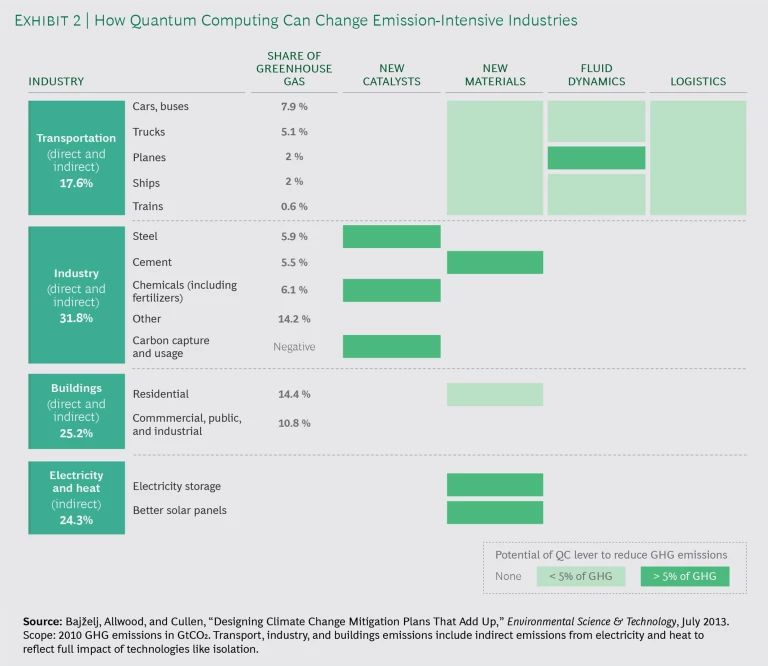Climate change has created a conundrum: even though many countries have a clear economic (and survival) case for significantly accelerating emission reductions, global political will has so far been dramatically insufficient to address the problem.
The same is true for corporate efforts. The COP25 negotiations in Madrid displayed the lack of global consensus; hope now turns to the World Economic Forum meeting in Davos, as well as to the COP26 negotiations in Glasgow, to spark much-needed action.
The lack of near-term political progress puts increasing focus on technological solutions that can either decisively improve the economics of current zero-emission technologies or contribute to the development of new ones. Quantum computing could be one such solution. Although it cannot be a substitute for short-term action, it can deliver critical relief in the medium term.
Quantum Advantage
Because quantum computers employ distributed probability amplitudes rather than work through sequential yes–no decisions, they have the potential to solve problems that are far beyond the reach of today’s machines. As one of the fathers of quantum computing, Richard Feynman, put it, “Nature isn’t classical, dammit, and if you want to make a simulation of nature, you’d better make it quantum mechanical.”
For example, if applied to current low-emission technologies, quantum computing could contribute to solutions that change how we generate and store power; how we build houses, cars, ships, and airplanes; how we power transportation; and even how we design long-standing industrial processes such as cement, steel, and fertilizer manufacturing. Add it all up and quantum computing–enabled technologies could one day address a majority of emissions.
Quantum computing–enabled technologies could one day address a majority of emissions.
Quantum computing’s impact is not as distant as some might assume. While its full potential is still decades away, recent advances indicate that early-generation machines—those that will be available in the 2020s and early 2030s—could contribute substantially to some of the highest-impact technologies for combating global warming. They could therefore start changing the economics for businesses in a number of industries within the next five to ten years.
The world must find ways to take collective action now against climate change. But that doesn’t prevent also looking down the road to when quantum computing could represent the kind of step change in capability that the world needs—especially if that road is not long. While it is too soon to know exactly where and when breakthroughs by still imperfect quantum machines could occur, we already can discern several areas where novel solutions could alter the global warming landscape. (See Exhibit 1.) (The timeline discussed herein is a best guess based on analysis and expert interviews conducted by BCG. The rate of progress will ultimately depend on actual technological advances, perhaps accelerated by public and private funding and public education efforts.)
New Catalysts
When it comes to emission reduction, some of the earliest applications for quantum computing could be among the most important. The coming decade—referred to as NISQ, for noisy intermediate-scale quantum—will see the scaling up of machines that are prone to errors and limited in their computation capabilities. Still, advances in hardware and software could enable these machines to accurately model molecular interactions involving 50 to 150 atoms, calculations that are well out of reach of classical computers. This capability could lead to the development of significantly better and more efficient chemical catalysts, which could in turn create breakthroughs in a number of carbon-intensive processes, including the following.
When it comes to emission reduction, some of the earliest applications for quantum computing could be among the most important.
Green Ammonia. The Haber-Bosch process for producing ammonia fertilizer currently consumes around 3% to 5% of all natural gas generated globally. It has not fundamentally changed since its invention a century ago. Understanding how bacteria produce ammonia naturally using significantly less energy and replicating the FeMoco molecule (the primary cofactor of natural nitrogenase) would be an enormous step forward. A new “green” production technology for cheap ammonia would not only bring down emissions in one of the most CO2-intensive chemical processes worldwide but also enable the use of ammonia as a carbon-neutral fuel (in shipping, for example). Google’s CEO has predicted that Haber-Bosch could be replaced within ten years.
Green Hydrogen Power. Accelerating the development of new catalysts for splitting water molecules, replacing expensive platinum and increasing the efficiency of current conversion processes, could significantly decrease the production costs for green hydrogen. This would help to displace methane steam reforming processes in industrial hydrogen production. Even more important, it could put low-carbon hydrogen within economic reach as an energy source for transportation and steel production. Better catalysts for the production of synthetic hydrocarbons (often synthesized from hydrogen) would enable the production of more-affordable emission-free fuels for aviation, shipping, and heavy transport, and thus help solve the long-term storage challenge in renewable power systems.
Carbon Capture. Better catalysts could significantly increase efficiency and lower the cost of binding carbon—both at the source and from the atmosphere. This could be a key enabler of industrial carbon-capture-and-storage applications and make captured CO2 more attractive as a feedstock in the “circular carbon economy.” In the longer term, better catalysts could also enable scalable negative-emission solutions through “direct air capture” (and, again, reduce the costs of synthetic hydrocarbons).
New Materials
In the decade following NISQ, scientists expect a step-change improvement in quantum computers’ ability to address more-complex problems, such as those involved in material science optimization. Lighter, stronger, and better-insulating materials that require less carbon to produce can reduce emissions from buildings, transportation, and the production of materials such as cement. These account for 25.2%, 17.6%, and 5.5% of global CO2 emissions, respectively.
For example, some polymer concretes already offer properties that are superior to those of traditional cement, including high compressive and impact strength, fast curing, low permeability, resistance to chemicals—and a smaller environmental footprint. Today, they are used mostly in niche applications because of their higher cost and other practical restrictions. Going forward, the expanded simulation capabilities of error-corrected quantum computers could devise better formulas that could lead to much less expensive production processes. Lighter and stronger materials could also increase the energy yield in cars, aircraft, trucks, and maritime vessels, as well as displace emission- or energy-intensive materials such as steel and aluminum.
Current photovoltaic cells have a 30% to 50% yield, leaving room for doubling efficiency with new cell materials. Similarly, electrical energy storage density could be improved with new battery materials (electrodes and electrolytes). Together, these new efficiencies would make solar power significantly more predictable and efficient.
Fluid Dynamics and Logistics
Error-corrected quantum computers would improve the design and operation of equipment affected by fluid dynamics, especially when coupled with better quantum data encoding (known as QRAM). For example, automakers, airplane manufacturers, and others rely on computational fluid dynamics in the design of their products. Today, they use moderately effective tools because simulations are limited by classical computers’ inability to model fluid behavior on large surfaces (or at least to do so in practical amounts of time). This entails expensive and laborious physical prototyping of components. With quantum computers, engineers could explore better designs that optimize both drag and lift and therefore reduce emissions.
Airbus, among others, is exploring how quantum computing can produce such solutions. It is looking specifically at how quantum computing can help optimize aircraft climb trajectory, which is especially important in short-haul flights, and improve wingbox design to optimize weight while maintaining structural integrity. The same logic applies to maritime transport, which, like aviation, accounts for as much as 2% of global emissions.
Another field for potential quantum optimization is the improvement of complex supply chains, which are notoriously difficult to optimize because of the many factors involved, such as product variants, transportation modes and routes, client constraints, and cost. Each factor can increase the problem size exponentially. Quantum computers have the capability to explore such problems more efficiently and extensively than classical computers and should offer advantages even relative to emerging AI-based approaches. Combined with the rise of new mobility solutions in the next 10 to 20 years, such as autonomous driving and shared transportation, this could result in savings in transportation energy.
From Quantum Discovery to Deployment
While the potential is real, reaching it will require considerable effort and investment. To generate truly global impact, quantum-enabled technologies will need to be successfully industrialized and deployed worldwide. (See Exhibit 2.) And while quantum computers’ modeling capabilities can support industrialization, successful deployment will depend on many other factors, such as the degree of improvement over previous processes and the impact of regulatory and economic incentives.
To accelerate progress, governments and industry need to assess their investments in quantum computing software, hardware, and talent. Such investments will benefit the planet, but they could also have a significant impact on national and corporate competitiveness. Here are a few potential areas of focus.
Climate Change–Related Algorithms. BASF and HQS Quantum Simulations have advanced the current state of the art in algorithms for replacing Haber-Bosch in fertilizer production. But these algorithms still require computers that can sustain 10 million quantum operations, so we need more innovation. Zapata Computing, whose founder pioneered important variational algorithms, has improved some earlier attempts by combining the capabilities of classical and quantum computers. In the near term, even mere “quantum inspired” approaches using classical computers introduced by Microsoft and others are promising.
Quantum Computing Hardware. Today’s quantum computers are still in the equivalent of classical computers’ vacuum tube age. The technologies that could represent the equivalent of the transistor (among them, superconducting, ion-trap, photon- or silicon-based, and topological) all require more research and funding.
Quantum Computing Talent. By our estimates, the quantum computing community probably has a few thousand scientists worldwide. Quantum skills take time to develop. The current talent shortages in artificial intelligence illustrate how companies can be thwarted abruptly when a high-impact technology makes the transition from research to development. Programs such as ETH Zurich’s master’s degree in quantum engineering could be worth introducing more broadly in universities and engineering schools.
The current talent shortages in artificial intelligence illustrate how companies can be thwarted abruptly when a high-impact technology makes the transition from research to development.
Quantum-Inspired Algorithms for Classical Computing. Classical computer algorithms can benefit from quantum computing’s new ways to look at problems (leveraging interference of distributed probability amplitudes) in combination with recent improvements in machine learning. They may well deliver imperfect but good-enough solutions sooner than the quantum hardware timeline—in particular during the NISQ decade. Machine learning is already able to approximate some wave function calculations that underpin the quantum chemistry use cases for new catalysts and new materials.
We need to intensify our efforts in the fight against climate change. Technology offers much-needed support. Quantum computing could help bring more low-carbon technologies into economic reach. It is in the best interest of governments and companies to fast-track progress in the race for our future.
BCG’s Center for Climate & Sustainability
We partner with clients across the public, private, and social sectors to align their strategy, operations, and stakeholder engagement with a low-carbon world. Our work is supported by BCG’s range of consulting experience across all industries and capabilities, as well as by our expanding reach of brands.








